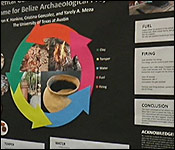
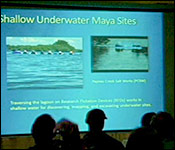
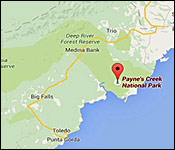
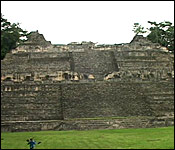
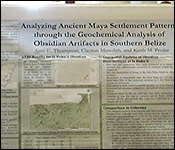
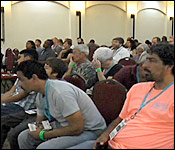 On Wednesday, we told you about the 14th Annual Belize Archaeology and Anthropology Symposium, which has been taking place all week in San Ignacio. It's an opportunity for all the researchers working with NICH to come together and discuss the progress in the work that they've been doing either within the remote communities, or at different Maya sites.
On Wednesday, we told you about the 14th Annual Belize Archaeology and Anthropology Symposium, which has been taking place all week in San Ignacio. It's an opportunity for all the researchers working with NICH to come together and discuss the progress in the work that they've been doing either within the remote communities, or at different Maya sites.
At this week's Symposium, we got an opportunity to see just how many partnerships between NICH and friendly universities it actually takes to keep the work going at Belize's archaeological sites. Daniel Ortiz has that story:
Daniel Ortiz reporting
Since the beginning of the week, archaeologists and anthropologists from all over the world have been attending the Belize Archaeology Anthropology Symposium.
Nigel Encalada - Director, ISCR
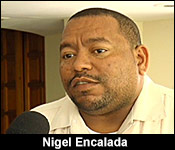 "The BASS Symposium we are in our 14th edition and it's the 5th edition that has featured papers in archaeology, anthropology and history. It's been an excellent week, I think it's been the best symposium that we have had yet. Just in terms of attendance our anthropologist, our historians, our archaeologist and the attendance, we have noted an increase in the participation of Belizeans."
"The BASS Symposium we are in our 14th edition and it's the 5th edition that has featured papers in archaeology, anthropology and history. It's been an excellent week, I think it's been the best symposium that we have had yet. Just in terms of attendance our anthropologist, our historians, our archaeologist and the attendance, we have noted an increase in the participation of Belizeans."
Dr. Arlen Chase, Ph.D. - Archaeologist, University of Central Florida
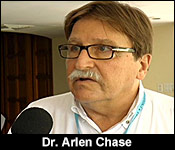 "It is for all of us. It's probably the most important conference of the year."
"It is for all of us. It's probably the most important conference of the year."
Dr. Alicia McGill, PhD - Anthropologist/Historian, North Carolina State University
"The support was extensive. It was really enjoyable to hear the questions that people asked. People had good suggestions for how do we connect with other researchers and Belizean institutions."
So, what kind of topics were these researchers treated to from this year's presenters? Well, over 30 hours spread out over 5 days, the leading lights of academia presented on a broad spectrum of fieldwork.
Just listen to the Archaeologist from Louisiana State University speak about diving the Punta Ycacos Lagoon. This is a body of water which makes up a part of the Paynes Creek National Park, located on the northeastern edge of the Toledo District. The evidence is that the Ancient Mayas used this location for their Salt Production industry.
Heather McKillop, Ph.D. - Louisiana State University
"Most of you know that for the last 10 years my team and I from LSU have been working at shallow under water sites in Paynes Creek National Park and who wouldn't want to continue there, spending all day snorkeling in the Caribbean. We go through a lot of sunscreen, drink a lot of water and we find great stuff. Someone's got to do it, might as well be us. Allen, come and visit. The video on the right which most of you have seen. I turned off the sound because as soon as I say I'm taking a video all the bad language comes out. So, thank you Tony for turning off the sound."
Dr. Arlen Chase, another archaeologist from the University of Central Florida has been working at the famous Caracol Archaeological site near to border in the Cayo District. He told us that he has been working on the tallest structure at the temple.
Dr. Arlen Chase, Ph.D.
"I've been working in Belize for the last 40 years and I'm the archaeologist that works back in Caracol. I just finished our 32nd second season. If you have been to Caracol you would notice that Caana is completely stabilized and part of that is due to our efforts in the early 90's with the 1st stabilization efforts in the efforts and the efforts of Jaime Awe and when my presentation was on with my wife was on the architecture of Caracol, but specifically focusing on the largest architecture complex, man-made complex which is Caana which rises 43 and half meters above the plaza area. What we attempted to do is keep with the theme that archaeology had selected which was architecture and so we examined the actual archaeology of Caana. Caracol extends over 2 hundred kilometers. Caana literally sits in the epicenter."
Daniel Ortiz
"Caracol? To those of us who know very little about archaeology would come to the conclusion that its a very well excavated, that the work seems to be almost complete."
Dr. Arlen Chase, Ph.D.
"We have barely scratched the surface of Caracol. Caracol could be worked for a 100 years and you would still be finding things."
And for the Anthropologists, Dr. Alicia McGill has been doing research in Crooked Tree Village.
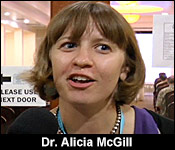 Dr. Alicia McGill, PhD
Dr. Alicia McGill, PhD
"I've been working in Crooked Tree since 2005 in the summer, I came down for the 1st time with my own graduate students, 2 women from the US to work on oral history and museum exhibit project to share with the community things that I had learned. Many people know a lot in village about their local heritage, have extensive knowledge about the local wildlife and the cashew processing and we all know Crooked Tree is famous for the cashew. We documented that in video and even though everyone in the village already knew about how the process works, they were enthralled with what was going on, because they could point out their family members and know that they are an expert on something that everybody else just doesn't know how to do."
Local Researcher Selene Solis chose to study the preservation of the Garifuna language in Belize City. She's found out that for a country which pats itself on the back for cultural diversity, Belizeans appear to be very wary of other ethnic groups who speak languages that they don't understand.
Selene Solis - Senior Researcher, ISCR, NICH
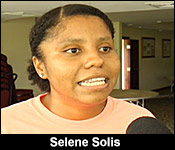 "The paper that I presented just today actually not too long ago focused on a language retrieval effort that's currently on going in Belize City, Why I chose Belize City is because I had a precursor in the 90's Mirtle Palacio I believe it was had done a research and she coined the term urban Garifuna so I was really interested in looking at how those urban Garifuna were getting on in Belize city 20 years on specifically as it relates to their language, language use, language transmission, and just general attitudes and ideologist towards their own culture and their own language in the space that they have been able to formulate. We as Belizeans really need to look at ourselves and evaluate how we look at our own cultural diversity. It's something that we promote heavily in tourism, heavily. So but in reality when we are here and when we are underground and we experience another let's say, somebody who is speaking a different, we tend to feel uncomfortable or feel that we are being gossiped about. There is an almost fear of, if not cultural diversity, then linguistic diversity, then a fear of the other, a fear of not knowing. Why that is I'm not sure but there's more work that needs to be done to figure that out."
"The paper that I presented just today actually not too long ago focused on a language retrieval effort that's currently on going in Belize City, Why I chose Belize City is because I had a precursor in the 90's Mirtle Palacio I believe it was had done a research and she coined the term urban Garifuna so I was really interested in looking at how those urban Garifuna were getting on in Belize city 20 years on specifically as it relates to their language, language use, language transmission, and just general attitudes and ideologist towards their own culture and their own language in the space that they have been able to formulate. We as Belizeans really need to look at ourselves and evaluate how we look at our own cultural diversity. It's something that we promote heavily in tourism, heavily. So but in reality when we are here and when we are underground and we experience another let's say, somebody who is speaking a different, we tend to feel uncomfortable or feel that we are being gossiped about. There is an almost fear of, if not cultural diversity, then linguistic diversity, then a fear of the other, a fear of not knowing. Why that is I'm not sure but there's more work that needs to be done to figure that out."
So, For the layman, it may be an overload of information, but for the professionals, it appeared that they were right at home - and maybe even enjoying - the efforts of their peers.
Dr. Arlen Chase, Ph.D.
"This is a very important conference and yes there is a lot of data that is dumped on us."
Dr. Alicia McGill, PhD
"And it's something that we struggle with all the time. In public history, we talk about how do we make history accessible."
Dr. Arlen Chase, Ph.D.
"But this is actually the only way that we can find out what our colleagues are doing and it allows us to see what they have been excavating, what they have found and that we can fit that in our own strategies and design new ways of doing things at each of our sites."
Nigel Encalada - Director, ISCR
"You begin to understand where people are coming from and the frame of their research and what that does, the interaction and the diversity of papers, what that does, is it allows you to think across research fields. So, if you are an historian, you begin to think in terms of human behavior and not just the facts. If you are an archaeologist and you are listening to a historian speak, you begin to think about the context of the work that you are doing."
By our count, the academics working in Belize sat through a total of 38 presentations running at an average of 30 minutes to an hour in certain instances.
| 
